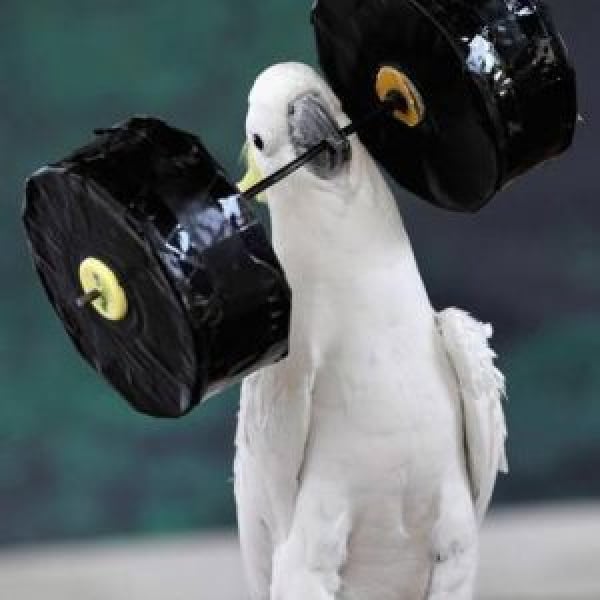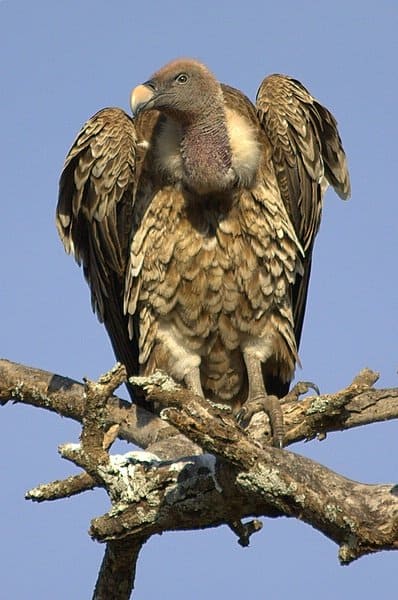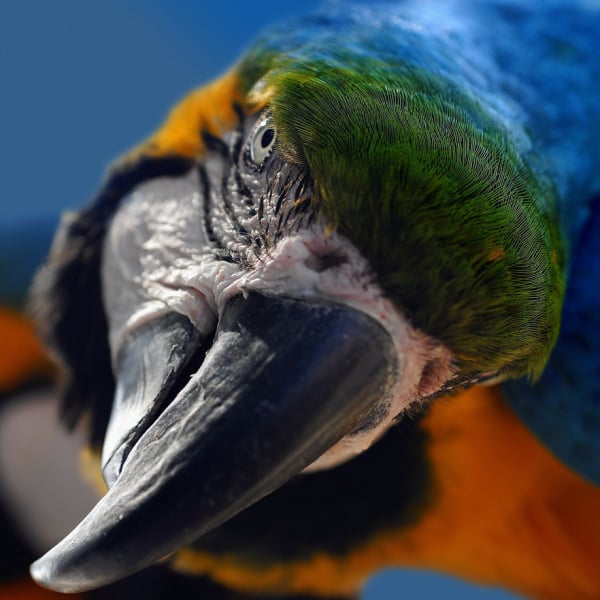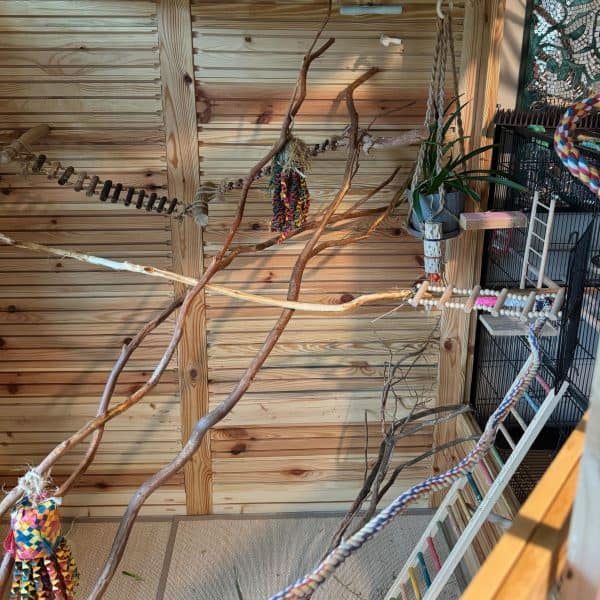
Exercise Your Bird – Why and How – Videos
Last Updated on by Mitch Rezman
We focus on bird and parrot nutrition a lot here because of the complexity of a bird’s anatomy.
Birds require far more energy than their ground-based counterparts.
Migratory birds fly at high altitudes where the air is thin.
You and I would require supplemental oxygen at those altitudes.
Editors note: Griffon Ruppell’s vultures have been reportedly seen at 35,000 feet (7 miles above the earth) by commercial airline pilots.
Their DNA enables them to extract oxygen from red blood cells more efficiently than any other animal on the planet

Rüppell’s Vulture (Gyps rueppellii) in the Serengeti, Tanzania.
Birds have two matching lungs just like mammals but they’re totally different organs.
Our lungs contain tubes that flow into little sacs.
Cul-de-sacs actually because air can only go in and out of them, never flow through them, to the outside.
They take up a good portion of our chest.
Air comes in from the mouth down to our trachea and then through a complex series of tubes – bronchi, actually – eventually into tiny air capillaries which then exchange gas between the ventilation system in the blood where it moves the oxygen to the bodies cells.
When you think of birds lungs think how water moves in and out of a sponge (video loads slowly).
Avian respiratory system ~ video
Air comes directly into the bird’s lungs and then into adjacent air sacs.
The sacs are believed to function kind of like bellows and push the air through the bird’s lungs.
Human lungs exchange air with every breath, and birds’ lungs hold a constant volume of air.
They inflate but they don’t deflate – they hold air.
Think about submarines – they rise and fall by pumping air into cavities when they want to go up, the air is replaced with water when they go down.
If birds’ lungs filled and emptied with every breath their altitude would constantly change.
The advantages of this “constantly inflated” design is clear.
Birds are able to stay on course easily and it allows them to have a much higher energy level than mammals.
Mammals lose energy just by breathing because of the actions of their lungs
How rapidly birds breathe is inversely proportionate to how much they weigh.
Parrots will take approximately 14 breaths per minute when at rest.
Bird breasts are different than ours.
When a parrot takes a breath, its chest muscles force its breastbone out then air is sucked in through its nostrils.
A safety note here: holding birds too tightly around their chest could suffocate them
The smaller the bird the larger its heart relative to its size.
The human heart is typically about one-half of 1% of body weight and the average heart rate at rest is 72 bpm.
Your bird or parrot’s heart can be anywhere from 1-1/2 to 2% of its body weight and have a standing heart rate of anywhere from 140-400 bpm.
When we work out we’re happy to have a 120 bpm heart rate during a brisk walk maybe 140 to 160 beats per minute while putting our body under stress.
A bird in flight can have a heart rate exceeding 1000 bpm. (Hummingbirds’ heartbeats have been measured as high as 1260 bpm.
Because hummingbirds are literally always on the verge of starving to death they’re able to store enough food to survive overnight and slow down their own metabolisms to conserve energy).
So we have these well-engineered flying machines that we insist on keeping in enclosed structures.
To complicate matters it’s almost impossible to tell if they’re healthy or not.
Birds generally don’t get fat.
Try taking a bird’s blood pressure – that’s a bit of a challenge.
The two easiest and most accurate ways to keep track of your bird’s health are to watch its poop and weigh it regularly.
A great deal of emphasis is placed on bird behavior and bird nutrition but time and effort also must be placed on exercising a bird in order to keep them healthy.
We provided some videos to help you get started on an exercise program for your bird if you haven’t already.
It’s no secret we are proponents of keeping birds flighted.
But as advocates for the birds who want to make sure that if you notice clipped you have the tools needed to exercise said bird.
“If a picture is worth 1000 words, how much is the video worth?
We hope these videos will help keep your bird in superb health and keep you, the caged Bird keeper on the right side of sanity.
Yes, we know birds are nuts and it’s not uncommon for them to make us crazy. Yet can’t help but love them” – mitchr
Ladders can be an essential part of your bird’s daily exercise routine as seen in this video “Get Your Bird To Exercise” – Parrot play stands and spiral bungees hung from the ceiling provide a wonderful opportunity for your bird to use its feet and legs.
Floor walking and wing flapping are simple activities your bird can do daily too.
Birds and exercise ~ video
Sometimes you do not need an elaborate parrot play stand.
In this video, a cockatiel does yoga-like stretching out his wings and is able to work his way up and down a rope perch attached to another perch suction cupped to a window ie shower perch).
Birds are happy to be out of their birdcage and in this case bask in the sunlight by the big glass door
In this video, the person becomes the parrot play stand. We see a female (Red) Eclectus parrot being held by the feet while flapping her wings.
Wing flapping is a great exercise because it helps push air through the lungs of your bird.
This is the equivalent of walking on a treadmill going nowhere but still getting exercise.
Someone must have gotten an A-plus for this science project. It is a wonderfully simple illustration of the functionality of a bird’s lung and how the air passes through it.
Inhalation and exhalation are explained in this remarkably simple animated diagram. It will help you understand the unidirectional flow of air through a bird’s lungs.
Bird Respiration ~ video
I don’t know if this is my favorite way to exercise a bird but there is clearly a special bond between this man and this blue and gold macaw.
We don’t know who’s enjoying themselves more, the man or the bird.
At the end of the day the bird got some exercise and the man well he got to play with his bird.
We recently spoke about providing the best quality of life for handicapped birds.
In this video, we watch a bird who has an issue with its foot and is taught to wave.
While raising its foot to wave, its full weight is then exerted on the handicapped foot giving it much-needed exercise so the bird can live as normal a life as possible.
Sometimes simple stretching exercises will help your bird feel better about himself.
The African gray in this video seems content on top of its bird’s cage and stretching its wings and feet.
Call it birdie yoga. What’s important is the bird is out of its cage and able to fully extend its wings.
If you have any comments or questions about the information we’ve been discussing here – please post them below.
Until next time
Mitch Rezman
Windy City Parrot, Inc
10/30/2022
Name*: Scott S
What kind of bird(s)? : Congo Gray, Elenora Too, show winning ‘Tiel
Message*: Diane P – my wife and I rescued an Elenora ‘Too 20 years ago this year. Sam was abused and badly neglected for the first thirteen years of her life. She has made remarkable progress, a year after we rescued her she would fly at me, claws forward and beak open. We clipped her then she took to launching herself off her “tree” at me when she was out of her cage.
It’s going to be a long road but building trust will happen with perseverance. We had an opportunity to work briefly with Ken Globus (aka The Bird Wisperer) and one thing we found that helped build trust with Sam is eye contact…you might give that a try with your guys.
Best of luck and hang in there, it ain’t over till it’s over.
Upload images of your bird and/or cage:
Author Profile
Latest entries
 The Traveling BirdJune 26, 2025Can You Name 5 Parrot Species That Are Living Wild in the USA?
The Traveling BirdJune 26, 2025Can You Name 5 Parrot Species That Are Living Wild in the USA? Bird BehaviorJune 26, 2025How is it Parrots Are Problem Solvers Social Animals and Even Use Tools?
Bird BehaviorJune 26, 2025How is it Parrots Are Problem Solvers Social Animals and Even Use Tools? Bird & Parrot AnatomyJune 25, 2025How a Tiny Chemical Modification Makes Parrots Nature’s Living Paintings
Bird & Parrot AnatomyJune 25, 2025How a Tiny Chemical Modification Makes Parrots Nature’s Living Paintings PigeonsJune 20, 2025How Do Parrots Thrive in Cities Outside Their Native Habitats?
PigeonsJune 20, 2025How Do Parrots Thrive in Cities Outside Their Native Habitats?
This Post Has 4 Comments
Leave a Reply
You must be logged in to post a comment.



Lisa
15 Apr 2018Thanks for this article and collection of videos! One of my two amazons is a clumsy flier, and I can’t handle him. So in case this helps anyone else who can’t handle their bird: first, you must have an up-up stick for a bird you can’t handle. 🙂 So, I get him on his up-up stick and walk him through his room, dipping him up and down slowly (you work up to this over time), and he flaps his wings the whole time then I let him ‘land’ on his cage. He loves it.
A few years ago I learned why he’s a clumsy flier. He was X-ray’ed and the vet said his wing was broken when he was little and it healed crooked. He was wild caught (legal import trade). So sad. I adopted him from someone in 1989. Much as I wish people would adopt vs. buying, thank goodness we’ve addressed importation and smuggling by breeding domestically. I saw him in a new light, imaging what he must’ve been through. He’s a tough customer, I can’t handle him, but we have a great relationship. I’ve given him space and let him be who he is. He lets me touch his toes, beak, and tail. That is enough! He has a best friend (wife), so he gets the touching and grooming he needs that way. “We took them out of the sky, we owe them..” – love that quote, you guys.
WindyCityParrot
16 Apr 2018Appreciate it Lisa, we’re big advocates of stick training. Have you thought about clicker training?
best mitchr
Lisa
16 Apr 2018Thanks, Mitch. I haven’t read about it much, is there something it would do for me? After 29 years together (!) we’re pretty set in our ways. He’s in a bonded pair, so I move the girl to wherever I want him and it’s done. 😉
[email protected]
30 Oct 2022what I have been doing with Arlo, the grey, (who just turned 31 on 25 October) is encouraging him to climb the stairs (she grabs a step with her beak, grabs with her toes,flaps up to the next one & repeats the whole thing until she’s at the top of the landing) She also likes to fly from her play perch to the stairs. Recently, she has started to use the ‘swing ring’ that I bought ages ago. It takes her a couple of minutes to manuever from the ring to her play stand, then fly to the bottom or top of stairs. She was quite sick a few years ago; vet thought she’d had a stroke….After 26 years of ‘good for her’ food and ‘not so good for her’ food, I guess ‘good living’ got her athlesclerosis. Vet gave a drug, she still takes, but I think vet says we will check her out before giving any more doses. When Arlo was so sick, I paid Pam Clark, who I really respect, and she gave me some good advice. I followed it, and slowly Arlo got better. (including the vet’s help & advice, too of course) Pam also told me how to switch Arlo from seed diet (she also always ate veggies/bean/grain mix, plus stuff she shouldn’t have eaten) to pelleted diet. She recommended Harrison’s, also mentioned TOPs. We use Harrisons. It was also the very first time I had been successful in switching Arlo to pellets… It took a while until she was eating them, with no seed involved. When I look back at how ill she was, i will never let that happen again. The first time after her stroke, it took 6 months for her to really be active, and it was slow going. It was during Christmas, when ARlo first used the rings again. She saw us put up the tree & decided to go over there, using the swing rings (that she hadn’t used for years) to climb over and yank the Christmas lights…..I knew she wanted to get better then.